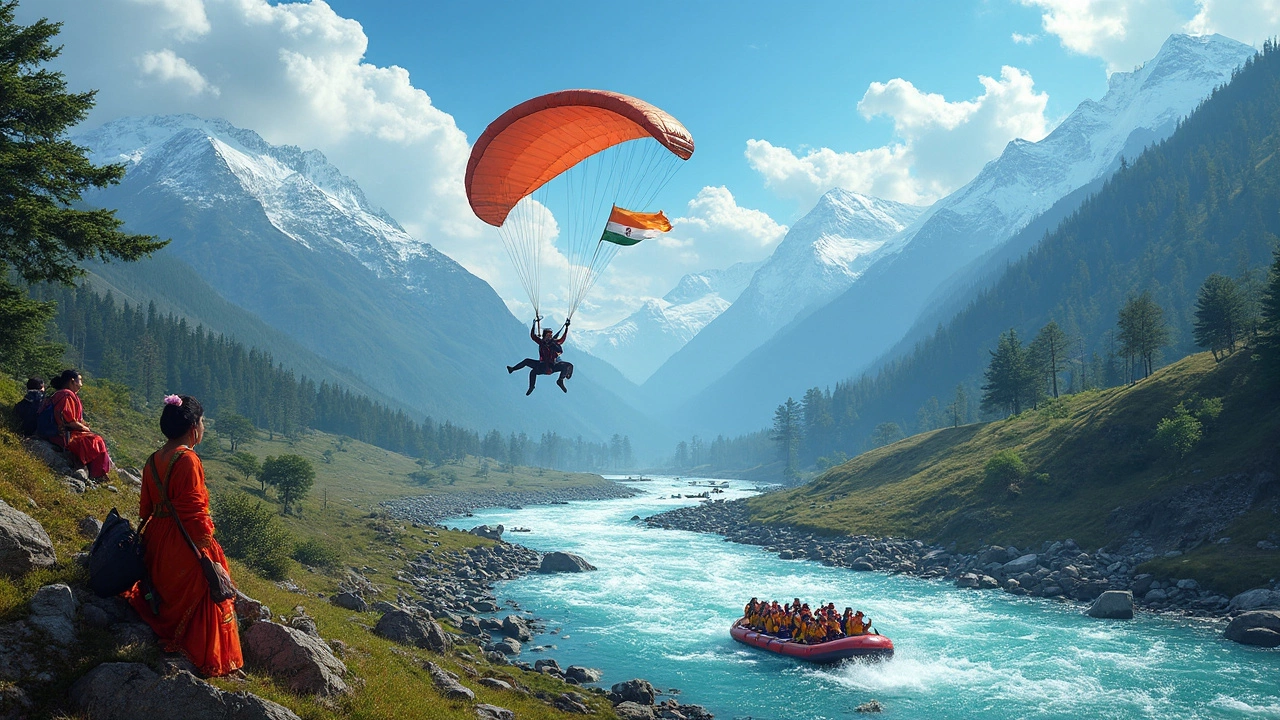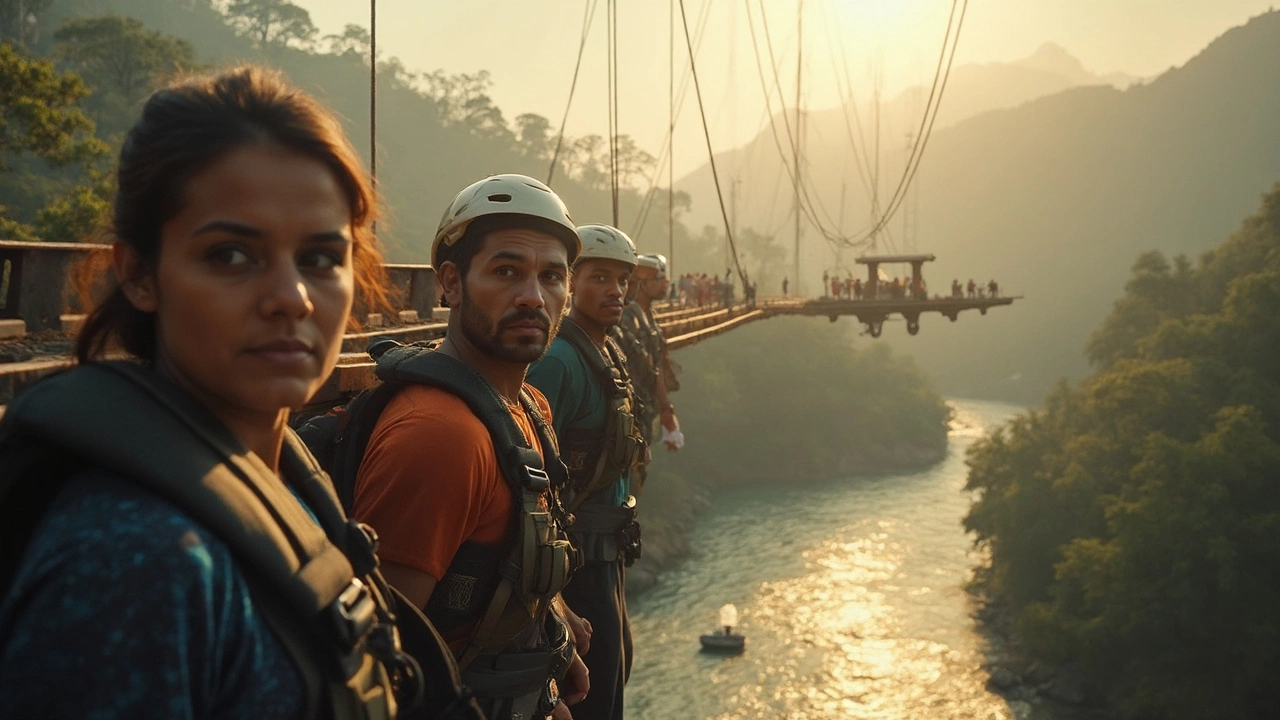Largest Adventure in India: What Tops the List in 2025?
 May, 14 2025
May, 14 2025
Ever wondered what really gets your heart pounding in India? If you're chasing the biggest adventure out there, it's not just about height or distance—it's about sheer thrill and the stories you'll tell for years after. India isn't just the land of spicy food or ancient temples. It's a giant playground for every kind of adrenaline junkie.
Right now, the talk of the town is Rishikesh, the unofficial adventure capital of the country. We're talking about the highest bungee jump platform in India, white water rafting that'll have you yelling over every wave, and treks that basically dump you out onto the roof of the world. The numbers are wild: bungee jumps from 83 meters, rapids ranked Grade III and IV, and trekking trails that take days to finish. These are not just activities—these are bragging rights.
The best part? Adventure in India is surprisingly accessible. It's got options for absolute beginners, seasoned daredevils, and even families with older kids. Plus, it doesn’t break the bank, so you don’t have to be a millionaire to try something you'll never forget. Buckle up, because the biggest adventure in India is way more doable than you might think.
- Size Matters: What Counts as India's Largest Adventure?
- The Adventure Capital: Rishikesh’s Wild Side
- Not Just for Pros: Tips for First-Timers
- Adrenaline Alternatives Across India
Size Matters: What Counts as India's Largest Adventure?
When someone asks about the largest adventure in India, it isn’t just about the tallest mountain or the longest road. In adventure sports, "largest" can mean biggest thrill, the most physical challenge, or even just the wildest stories to share. In India, the numbers stack up pretty well—some activities are literally massive in scale.
For starters, bungee jumping in Rishikesh offers the country’s highest jump platform at 83 meters (that’s like leaping off a 26-story building). It’s not just about the height but the guts it takes to step off the edge. Then there’s river rafting on the Ganga: over 35 kilometers of rapids between Shivpuri and Rishikesh with Grade III and IV rapids, making it India’s most famous stretch for white water action.
Trekking in India also gets serious. The Chadar Trek in Ladakh covers over 100 kilometers of icy terrain—imagine walking on a frozen river for days at -20°C. Meanwhile, Himalayan expeditions to peaks like Stok Kangri invite you to summit above 6,000 meters. That’s nosebleed altitude, and yes, anyone reasonably fit with some prep can join.
For those eyeing something different, skydiving in Mysore drops you from 10,000 feet up. Paragliding at Bir Billing gets you the highest takeoff site in Asia, with flights sometimes stretching longer than 30 minutes if the wind gods are happy.
| Adventure | Location | Record/Stat | Best Time/Season |
|---|---|---|---|
| Bungee Jumping | Rishikesh | 83 meters (highest in India) | Oct–Mar |
| Chadar Trek | Ladakh | ~100 km on frozen river | Jan–Feb |
| White Water Rafting | Rishikesh (Shivpuri route) | 35 km, Grade III-IV rapids | Sept–June |
| Skydiving | Mysore | 10,000 feet jump | Oct–Feb |
| Paragliding | Bir Billing | Highest take-off in Asia | Oct–June |
So, what makes an adventure the "largest"? It’s really a mix of stats, scale, stories, and the crazy feeling you get in the moment. India’s got a way of turning even simple activities into epic tales—just pick the one that calls your name.
The Adventure Capital: Rishikesh’s Wild Side
When folks talk about adventure sports in India, Rishikesh always tops the charts. No other place in the country rolls together as much action—bungee, rafting, cliff jumping, and more. It’s not just hype. Rishikesh is officially home to the highest fixed-platform bungee jump in India (83 meters or around 272 feet). If you want your pulse racing, this is the spot.
The Ganga here isn’t a peaceful river. Come March to June or September to November, the water roars with white-water rafting groups. You can pick different stretches—from family-friendly bits to pro-level rapids that’ll send you flying. Most stretches include 12 to 24 kilometers, with rapids graded III and IV. In plain English: there are enough big splashes to get you shouting, but you don’t need to be a pro kayaker to join in. The tricks? Listen to your instructor and don’t chicken out of paddling hard when the water gets bumpy.
If you think you’ll just stand on the riverbank, guess again. Rishikesh also dials up adventure with:
- Giant swing on India’s longest swing setup (75 meters arc), sometimes done as a double.
- Flying fox rides zooming over river valleys at up to 140 km/hr.
- Cliff jumping from safe, instructor-approved spots into deep, clear pools.
- Short Himalayan treks starting right out of town—one of the most popular is the Neer Garh waterfall hike.
Don’t just take my word for it—check out the numbers below. They show why Rishikesh still rules for the largest adventure in India:
| Activity | Max Height/Distance | Peak Season | Approx. Cost (INR) |
|---|---|---|---|
| Bungee Jumping | 83 meters | Sept–Jun | 3,700–5,000 |
| White Water Rafting | 24 km | Mar–Jun, Sept–Nov | 1,000–2,500 |
| Giant Swing | 75 meters arc | Sept–Jun | 3,200–4,000 |
| Flying Fox | 1 km (zipline) | Year round | 1,800–3,000 |
Before you go, double-check age and weight limits (bungee jumping: 18+ years, 40–110 kg). Most providers have strict rules on alcohol and fitness. If you’re coming with a group, it’s smart to book slots online—weekends fill up quick. Locker rooms, changing spaces, and shuttle buses are usually included in the price. Feeling nervous? Don’t sweat—most first-timers leave wishing they’d tried even more.

Not Just for Pros: Tips for First-Timers
Jumping into adventure sports can feel intimidating. But here’s the truth: you don’t need to be super fit or a daredevil to try India’s wildest activities. Plenty of first-timers show up in Rishikesh and end up bungee jumping, rafting, or even tackling a simple trek. The scene is beginner-friendly, and safety standards have actually improved a lot since 2020.
If you’re nervous about signing up, remember the words of Sandeep Chauhan, lead safety instructor at a top Rishikesh adventure center:
"We check all equipment before every jump or ride. Most injuries happen if people ignore the guide’s instructions. Listen up, and you’re good to go."
So, what’s good to know before you take on your first big thrill?
- Always go with licensed operators. Ask to see their certification—no operator in Rishikesh minds if you ask.
- Check age and health requirements. For example, bungee jumping in Rishikesh requires you to be at least 12 years old and under 110 kg.
- Pay attention during safety briefings. Guides usually cover helmet fit, lifejacket checks, and how to listen for commands on the water.
- Dress right: quick-dry clothes, sturdy shoes (no flip-flops), and no jewelry.
- Don’t eat a heavy meal before activities like rafting or bungee—it can make you sick, for real.
- Keep your phone and valuables with staff or in lockers. Most places have waterproof GoPros if you want pics.
If you’re still on the fence, check out this quick cheat sheet of popular first-timer adventures around Rishikesh:
| Activity | Minimum Age | Cost (INR) | Best Time |
|---|---|---|---|
| River Rafting (Grade III) | 12+ | ₹800-₹1200 | Sept-June |
| Bungee Jumping | 12+ | ₹3500-₹4000 | Sept-June |
| Flying Fox | 12+ | ₹1800-₹2500 | Year-round |
| Beginner Trek | 10+ | ₹1000-₹2000 | Oct-March |
Getting into the largest adventure in India scene is easier than you’d think. Operators know most of their customers are new to this and handle all the details. Show up, strap in, and let the adrenaline do its thing. If your hands get clammy, that's normal—you’re in good company!
Adrenaline Alternatives Across India
Think India is all about Rishikesh? Not even close. There’s a wild scene for adventure sports in spots you probably haven’t thought about. Here’s where the real thrill-seekers head when they want brag-worthy stories and no crowds.
- Largest adventure in India isn’t just bungee jumps or rapids. Paragliding in Bir Billing, Himachal Pradesh, is on most bucket lists. You launch from 2,400 meters, and the updrafts let you soar over lush valleys. This place draws pro pilots from 60+ countries for world championship events.
- Next up, Andaman Islands. Scuba diving in Havelock will have you swimming with manta rays, turtles, and even the occasional harmless shark. Visibility reaches 40 meters on a good day—hard to beat.
- If trekking is more your pace, try the Chadar Trek in Ladakh. You’re literally walking on the frozen Zanskar river. It’s only open a few weeks each winter, and it’s as raw as it gets. Bring serious cold gear—temperatures can drop below -20°C.
- Down south, Dandeli in Karnataka is famous for white-water kayaking. Their river festivals bring in top paddlers every year, and you can usually find reliable grade II-III rapids even when other rivers dry up.
- Skydiving has also picked up in Mysore, Karnataka and Deesa in Gujarat. You’re jumping from 10,000 feet out of a Cessna—there’s nothing quite like it in this part of the world.
Check out some quick stats below on these top picks:
| Adventure Spot | Main Activity | Best Season | Key Stat |
|---|---|---|---|
| Bir Billing, HP | Paragliding | Oct-Jun | World's 2nd highest take-off point (2,400m) |
| Havelock, Andaman | Scuba Diving | Nov-May | 40m visibility; 50+ dive sites |
| Ladakh (Chadar) | Trekking | Jan-Feb | -20°C; 9 days ice trek |
| Dandeli, Karnataka | Kayaking | Oct-Mar | Class II-III rapids |
| Mysore, Karnataka | Skydiving | Year-round | 10,000 ft tandem jumps |
There’s no shortage of alternatives if you’re looking to push your limits. Always go with licensed operators, double-check safety records, and invest in travel insurance. It beats getting stuck halfway up a mountainside or trying to outswim a jellyfish in the Andamans—trust me on that one.